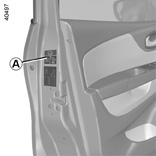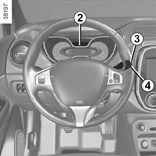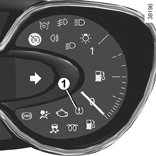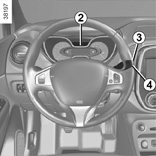TYRE PRESSURE LOSS WARNING
  |
If fitted on the vehicle, this system warns the driver of pressure loss in one or several tyres.
System identification
There are two tyre pressure loss warning systems: - System A: can be seen on the label A in the vehicle. To verify its presence, open the driver’s door. - System B: can be seen on the label A in the vehicle.
|
 |
SYSTEM A
Operating principle
This system detects a loss of pressure in one of the tyres by measuring the wheel speed while driving. Warning light 1 comes on to alert the driver in the event of insufficient pressure (deflated wheel, punctured tyre, etc.).
Operating conditions
The system should be reset with an inflation pressure equal to that given on the tyre inflation pressure label. Otherwise it risks not giving a reliable warning in the event of a significant loss of pressure. Please refer to the information on “Tyre pressures” in Section 4.
In the following situations, the system risk coming into action late or not functioning correctly: - system not reset after reinflation or any operation on the wheels; - system badly reset: different inflation pressures from the recommended pressures; - significant change in load or distribution of load on one side of the vehicle; - sporty driving with strong acceleration; - driving on snowy or slippery surface; - driving with snow chains; - fitting a single new tyre; - use of tyres not approved by the network. -...
|
This function is an additional driving aid.
However, the function does not take the place of the driver. It cannot, therefore, under any circumstances replace the vigilance or the responsibility of the driver.
Check the tyre pressures, including the emergency spare wheel, once a month.
 |
SYSTEM A (cntd.)
Resetting the standard level for the tyre pressures
This should be done: - after each reinflation or readjustment of the pressure of one of the tyres; - when the standard tyre pressure needs to be changed to adapt to usage conditions (empty, carrying a load, motorway driving, etc.); - after changing a wheel; - after using the tyre inflation kit; - after swapping a wheel (however, this practice is not recommended).
It should always be done after checking the tyre pressure of all four tyres when cold.
Tyre pressures must correspond to the current usage of the vehicle (empty, carrying a load, motorway driving, etc.).
Resetting procedure
With the ignition on: - repeatedly press one of the buttons 3 or 4 to select the “TYRE PRESSURE : SET TPW” function on the display 2; - press and hold (around 3 seconds) button 3 or 4 to start initialisation. The display of the message “SET TPW LAUNCHED ” for around five seconds indicates that the reset request for the tyre pressure reference value has been taken into account.
Reinitialisation is carried out after a few minutes’ driving.
Display
The display 2 on the instrument panel informs you of any tyre pressure faults (flat tyre, punctured tyre, etc.).
“INFLATE TIRES AND SET TPW”
Warning light comes on, along with the message “INFLATE TIRES AND SET TPW”. They indicate that at least one tyre is flat or punctured. In the event of a flat tyre, inflate the relevant tyre. In the event of a puncture, change the tyre or consult an authorised dealer. Check and readjust the pressure of the four tyres when cold, and launch the reset of the tyre pressure reference value. Warning light goes out after launching the reinitialisation of the tyre pressure reference value.
SYSTEM A (cntd.)
“RECALIBRATE SET TPW”
The warning light flashes for several seconds, then stays on, along with the message “RECALIBRATE SET TPW”.
They indicate that the request to reset the reference value of the tyre pressures must be restarted.
“TPW NOT AVAILABLE”
The warning light flashes for several seconds, then stays on, along with the message “TPW NOT AVAILABLE”. They indicate that the vehicle is equipped with an emergency spare wheel which is smaller than the other four and that it is fitted to the vehicle.
“CHECK TPW”
The warning light flashes for several seconds, then stays on, along with the message “CHECK TPW”.
This message is accompanied by the warning light ©. They indicate a system fault. Please consult an authorised dealer.
Readjustment of tyre pressures
The tyre pressures must be adjusted when cold (please refer to the label located on the edge of the driver’s door).
If tyre pressures cannot be checked when the tyres are cold, the recommended pressures should be increased by 0.2 to 0.3 bar (3 PSI).
Never deflate a hot tyre.
After each reinflation or readjustment of the tyre pressure, launch the reinitialisation of the tyre pressure reference value.
Replacing wheels/tyres
Only use equipment approved by the brand network, or the system risks being activated late or not operating correctly. Please see the information on “Tyres” in Section 5.
After each change of wheel/tyre, readjust the tyre pressure and launch the reset of the tyre pressure reference value.
Emergency spare wheel
If fitted on the vehicle, readjust the tyre pressure and launch the reinitialisation of the tyre pressure reference value.
Tyre repair product and inflation kit
Only use equipment approved by the brand network, or the system risks being activated late or not operating correctly. Please refer to “Tyre inflation kit” in Section 5.
After using the tyre inflation kit, readjust the tyre pressure and launch the reinitialisation of the tyre pressure reference value.
|
The sudden loss of pressure in a tyre (burst tyre, etc.) cannot be detected by the system.
 |
SYSTEM B
Operating principle
Each wheel (except for the emergency spare wheel) has a sensor in the inflation valve which periodically measures the tyre pressure while driving.
Warning light 1 comes on to alert the driver in the event of insufficient pressure (deflated wheel, punctured tyre, etc.).
Resetting the standard level for the tyre pressures
This should be done: - when the standard tyre pressure needs to be changed to adapt to usage conditions (empty, carrying a load, motorway driving, etc.); - after swapping a wheel (however this practice is not recommended); - after changing a wheel.
It should always be done after checking the tyre pressure of all four tyres when cold.
Tyre pressures must correspond to the current usage of the vehicle (empty, carrying a load, motorway driving, etc.).
|
This function is an additional driving aid.
However, the function does not take the place of the driver. It cannot, therefore, under any circumstances replace the vigilance or the responsibility of the driver.
Check the tyre pressures, including the emergency spare wheel, once a month.
 |
SYSTEM B (cntd.)
Resetting procedure
With the ignition on: - repeatedly press one of the 3 or 4 buttons to select the “TYRE PRESSURE SET ” function on the display 2; - press and hold (around 3 seconds) button 3 or 4 to start initialisation. The message “PRESSURE REF ONGOING” is displayed for approximately 5 seconds. The request to reset the reference tyre pressure value has been taken into account.
Reinitialisation is carried out after a few minutes’ driving.
Note: the standard tyre pressure cannot be less than that recommended and indicated on the door frame.
Display
The display 2 on the instrument panel informs you of any tyre pressure faults (flat tyre, punctured tyre, etc.).
“ADJUST TYRE PRESSURE”
Warning light comes on, along with the message “ADJUST TYRE PRESSURE”. These indicate that at least one tyre is flat. Check and, if necessary, readjust the pressures of the four wheels when cold. The warning light goes off after a few minutes’ driving.
SYSTEM B (cntd.)
“PUNCTURE”
The warning light comes on steady, accompanied by the message “PUNCTURE” and a beep.
This message is accompanied by the warning light ®.
They indicate that at least one wheel is punctured or severely underinflated. Replace it or contact an authorised dealer if it is punctured. Top up the tyre pressure if the wheel is deflated.
“CHECK TYRE PRESSURE SENSORS”
The warning light flashes for several seconds, then stays on, along with the message “CHECK TYRE PRESSURE SENSORS”.
This message is accompanied by the warning light ©.
They indicate that at least one tyre is not fitted with sensors (e.g. emergency spare wheel). In other cases, contact an authorised dealer.
Readjustment of tyre pressures
The tyre pressures must be adjusted when cold (please refer to the label located on the edge of the driver’s door). If tyre pressures cannot be checked when the tyres are cold, the recommended pressures must be increased by 0.2 to 0.3 bar (3 PSI).
Never deflate a hot tyre.
Replacing wheels/tyres
This system requires specific equipment (wheels, tyres, hubcaps, etc.). Please see the information on “Tyres” in Section 5. Contact an approved Dealer to fit new tyres and to find out about available accessories compatible with the system and available from your dealer network: the use of any other accessory could affect the correct operation of the system or damage a sensor.
Emergency spare wheel
If the vehicle is equipped with an emer- gency spare wheel, it will not have a sensor.
Tyre repair product and inflation kit
Because the valves are specially designed, only use equipment approved by the approved network. Please refer to “Tyre inflation kit” in Section 5.
|
The sudden loss of pressure in a tyre (burst tyre, etc.) cannot be detected by the system.
Warning light ® requires you to stop immediately, for your own safety, as soon as traffic conditions allow.